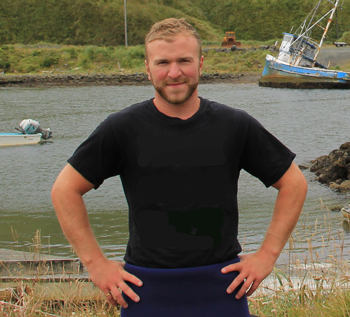East, West Coast Aquaculture Plans Require Similar Scrutiny
by Noah Oppenheim

Noah Oppenheim is the executive director of the Pacific Coast Federation of Fishermen’s Associations.
Around a month ago news broke that Canada’s Liberal Party was formally adopting a policy to transition British Columbia’s net pen finfish aquaculture programs to shoreside production facilities as a part of its election platform. With Canada’s recent elections keeping the Liberals in power for another cycle, one can assume that this policy will be implemented. Approaches to finfish production in the United States has historically fl owed southward from Canada, and with the Canadian West Coast’s shift towards ‘recirculating aquaculture systems’ (RAS), this same pattern may evolve in shoreside systems on the home front.
As a Landings reader you are probably familiar with Nordic Aquafarms, the Norway-based shoreside aquaculture company that is developing a land-based Atlantic salmon production facility in Belfast. You may be less familiar with the Belfast fish farm’s West Coast twin, a similarly sized shoreside facility proposed for construction on the Samoa Peninsula near Eureka in northern California. A Nordic Aquafarms’ subsidiary called California Marine Investments recently secured a 3-year lease from the Humboldt Bay Harbor, Recreation and Conservation District with the option of a 30- or 50-year extension. Similar to the Belfast facility, the Samoa facility would use a mixture of saltwater and municipally supplied freshwater to produce around 30,000 tons of product per year and discharge around 7.7 million gallons of effluent into the ocean. It is unclear what species the Samoa facility will grow; options include non-native Atlantic salmon or native steelhead trout, among others.
Nordic plans to use its preliminary lease period to remediate the site (formerly a pulp mill) where it intends to build and begin the arduous California water quality and coastal zone management permitting processes. These permits will be far more difficult to secure than their Maine equivalents because of California’s far more comprehensive and strict water quality standards, and it’s unlikely that the full California permitting process can be completed in just three years.
Eureka is home to the Humboldt Fishermen’s Marketing Association (HFMA), one of the members of our Federation. Neither HFMA nor PCFFA has taken a formal position on Nordic’s proposed California facility, but we will monitor its progress closely and participate in the public aspects of the various permitting processes to ensure that the project minimizes and, if necessary, mitigates impacts to fisheries.
It has been interesting to watch from afar as the conversation about the Belfast facility has proceeded. Last year the Maine project was perhaps a year ahead of California’s. That gap may widen as the greater inherent complexities of site remediation, seismic engineering, decisions on what species to produce, and water quality permits in California are dealt with. And by the time these decisions are made, and Nordic comes up for air with a final project configuration, the state and federal aquaculture policy landscape may have shifted significantly.
Efforts to develop RAS in the U.S. are part of broader policy discussions on aquaculture that have been quietly evolving in Washington, DC, as well as California’s capitol Sacramento. I believe it’s worthwhile for both California and Maine fishermen to contemplate these dynamics.
The Washington discussion drives the approaches that states choose or are forced to take, and it certainly drives the flow of programmatic funding and grants to development. The current legislative push for aquaculture permitting at the federal level is being led by a collection of aquaculture and animal feed industry members, primarily Midwestern corporate soybean growers. The animal feed industry has been the major proponent of the efforts to permit net pen finfish aquaculture leases in federal waters, but legislative and policy efforts in Congress and at NOAA would certainly steer additional federal resources towards shoreside development as well. California fishermen have been engaging on this issue, insisting in particular that there’s an airtight requirement for consistency with state laws and regulations in any federal net pen permitting programs. This would benefit all states that have a stake in supporting their wild capture fisheries.
Our organization has long argued that finfish aquaculture must be held to the same high environmental standards as commercial fisheries. That means, first and foremost, eliminating negative impacts on fish stocks and the marine environment. Innovative approaches in recirculating aquaculture systems are common, and there’s quite a bit of energy focused on making these systems better (rightfully so). True closed loop recirculatory systems ensure that no waste leaves the product cycle and removes the need for close proximity to marine ecosystems. Some closed loop systems have found ways to use nutrient byproducts for other uses. For example, experimental efforts are underway to capture methane byproducts of fish waste for use as fuel to power circulation pumps, limiting overall environmental impact and reducing energy usage. One sturgeon farm in California has figured out how to use fish waste to fuel the growth of another product — butter lettuce.
California’s fishing communities, consumers, and state agencies will make high demands of finfish aquaculture producers if they’re going to be welcomed into the complex seafood industry landscape here. Maine can certainly do the same.
